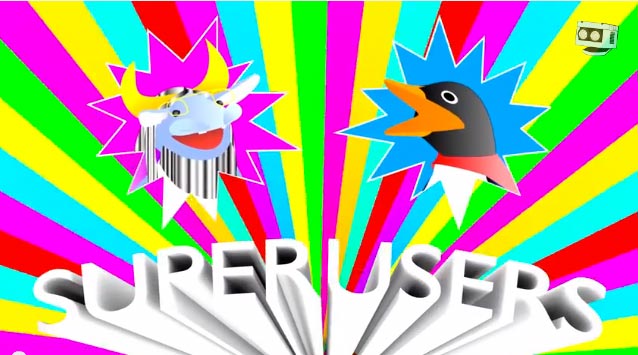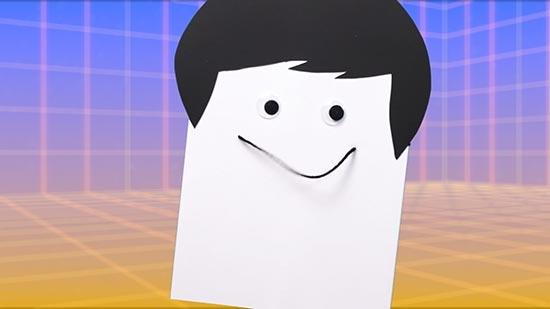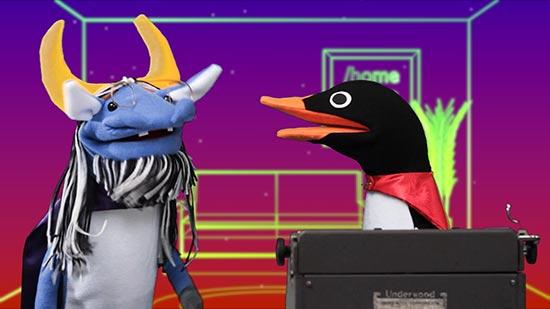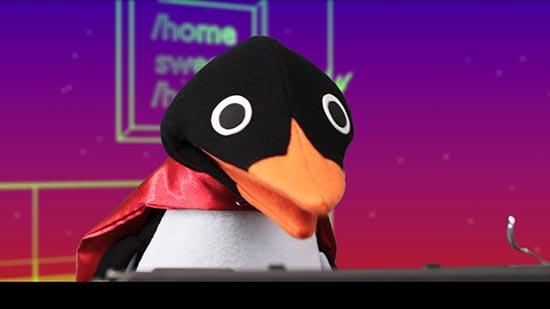Learn GNU/Linux the Fun Way

Sometimes a gift just falls in your lap. This month, it came in the form of an e-mail out of the blue from Jared Nielsen, one of two brothers (the other is J.R. Nielsen) who created The Hello World Program, "an educational web series making computer science fun and accessible to all". If it had been just that, I might not have been interested.
But when I looked at it, I saw it was hugely about Linux. And the human story was interesting too. Wrote Jared, "Working in rural Utah with minimal resources, we combine technology and craft to make educational yet entertaining videos and tutorials. Learn to code with our cute and clever puppets." So I said I'd like to interview them, and here's how it went.

DS: What got you going on this?
JN: Growing up, we wanted to be making creative media, such as games, videos, animations, etc., but in the days before the Internet, training was either difficult or expensive to find, especially in small-town Utah. We figured things out on our own, through trial and error, visits to the library and countless hours watching PBS. The Hello World Program is the show we wish we watched as kids.
DS: Do you or your brother have kids yourselves?
JN: Neither of us have kids, but we are both kids at heart.
DS: How long have you been doing it?
JN: We started kicking around ideas for an educational Web series in January 2012. Then we sat on our hands for a few months. We published our first video, "What Is a Robot?" in May of that year. Since then, The Hello World Program has significantly evolved. We introduced several new characters and expanded our scope to include Web development and programming.
DS: Where in rural Utah are you? (A side thing—I love Utah and have shot it a lot from the air.)
JN: Our home is Richfield, the gateway to adventure in Southern Utah.
DS: Cool! I shot your house from the sky just this past May 4th, in fact. (Here it is).
So, why Linux? We love Linux here, but not all computer science education starts with Linux, especially for kids. But you started there, which is very cool.
JN: Linux is the future! So we hope. Between the two poles of servers and smartphones—and the ubiquity of computers—we think the majority of users will eventually run a Linux distribution. One of our goals is to remove the economic barrier associated with learning computer science. Not only are the majority of Linux distros free, they are amazingly powerful and customizable and can breathe new life into old hardware.
Linux is also very hands-on, and learning it is also learning how a computer works. Other popular operating systems obscure the inner workings of the computer from the user. With Linux, students can choose how deep they want to dive into their machines.

DS: And you do all your production on Linux?
JN: Yes. We have such an appreciation for this operating system that we challenged ourselves to produce all of our media using Linux machines. We edit our videos with Lightworks. Our computer graphics are rendered in Blender. Our audio is processed using Audacity and Ardour, and our stopmotion animations are created using Entangle and compiled with avconv.
DS: Why puppets? (Side thing—my daughter Colette is a college professor who teaches puppet theater.)
JN: We learned about the world by watching Sesame Street, The Muppets and Mr. Rogers' Neighborhood. We wanted to create a show in the same vein with a contemporary sensibility. We loved the idea of merging analog craft with digital technology. In addition to puppets, a lot of our new content features stopmotion and hand-drawn animation as well as 3-D computer-generated animation.
DS: Why Python? We can guess, but we'd rather ask anyway.
JN: Python is an excellent choice for a beginner because it issues immediate results, it's very easy to read, and it can be used for a wide variety of applications. Best of all, it is included with most Linux distributions.

DS: Do you teach locally as well as on-line (for example, in local schools)? If so, how and where?
JN: We ran workshops with hacker/Makerspaces in the past, but found that our two-man team didn't have the time and resources necessary to teach and continue producing new content for our site.
DS: Do you have commercial or other ambitions besides what you're doing now? (Such as seeing these adopted in schools?)
JN: We would love to see our curriculum adopted in schools, though our ambitions are more autodidactic. Our primary goal is to empower young people to make their own media.
DS: Do you have a business with this as well?
JN: Yes. We're bundling our videos and selling them as a digital download. Our first complete segment, Daisy's Web Dev Diary, is available for purchase via Gumroad.
We're also planning to release e-books for each of the four tracks of The Hello World Program. And we're slowly building a merchandise store, for fans to purchase Hello World-themed T-shirts, stickers and posters.
DS: You identify on Twitter as a "Creative media company and think tank". Tell us more about both (especially the think tank part).
JN: The Hello World Program is our first project. As a creative media company, we are producing an educational and entertaining series of videos and tutorials combining art and technology. As a think tank, we recognize that understanding the basics of computer science will be a necessary skill set for the future. Through STEM initiatives, technological literacy will be taught to students at a younger age and eventually incorporated in standard curriculum. We're predicting that Linux and Python will be at the forefront of this movement. We support an open-source future and consider our current project a contribution to furthering the cause.
Otherwise, we're perpetually brainstorming new endeavors beyond puppets and video. But we're not ready to talk about them yet.

DS: Can you give us some success stories with kids?
JN: Our booth at Maker Faire Bay Area 2013 was wildly successful. It was titled "Robot Puppet Party", and we invited young makers to use our puppets to create their own short videos. We were awarded two Editor's Choice blue ribbons. But more important, the kids loved it.
We're also launching an Indiegogo campaign called "Hands-On Computer Science: The Hello World Program", which should go up in September.
DS: Good. That's just in advance of this issue of the magazine. Any other projects?
JN: We're launching a new segment, "Superusers: The Legendary GNU/Linux Show".
DS: Excellent! I like Aramis the Gnu and Adalie the penguin!
JN: We're also launching a crowdfunding campaign on Indiegogo that should be up by the time you read this.
DS: Where can readers follow you?
JN: Find us at https://www.dototot.com and on Twitter at https://twitter.com/dotototdotcom or https://twitter.com/helloworldshow.

